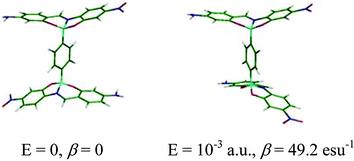Synthesis, characterization and nonlinear optical (NLO) properties of a push–pull bisboronate chromophore with a potential electric field induced NLO switch†
Abstract
A new bisboronate with five six-membered ring heterobicycles was prepared by reaction of [2-(2-hydroxy-4-diethylaminobenzylidene)amino]-5-nitroaminophenol and 1,4-phenyldiboronic acid, and its quadratic nonlinear optical (NLO) response was compared to that of a related monoboronate species. A computational investigation conducted within the framework of the DFT theory, at the B3PW91/6-31G* level, indicates that, while the diboronate derivative exhibits a centrosymmetric conformation in the ground state, and hence a vanishing quadratic hyperpolarizability (β), the application of an external electric field provides a gradual intramolecular rotation of the two “push–pull” sub-units which reaches 128° for a field intensity of 10−3 a.u. and leads to a β value equal to 49.2 × 10−30 cm5 esu−1. This result suggests a possibility for a molecular NLO switch induced by an electric field in such systems. Experimentally, the NLO response measured by the electric field induced second harmonic (


 Please wait while we load your content...
Please wait while we load your content...